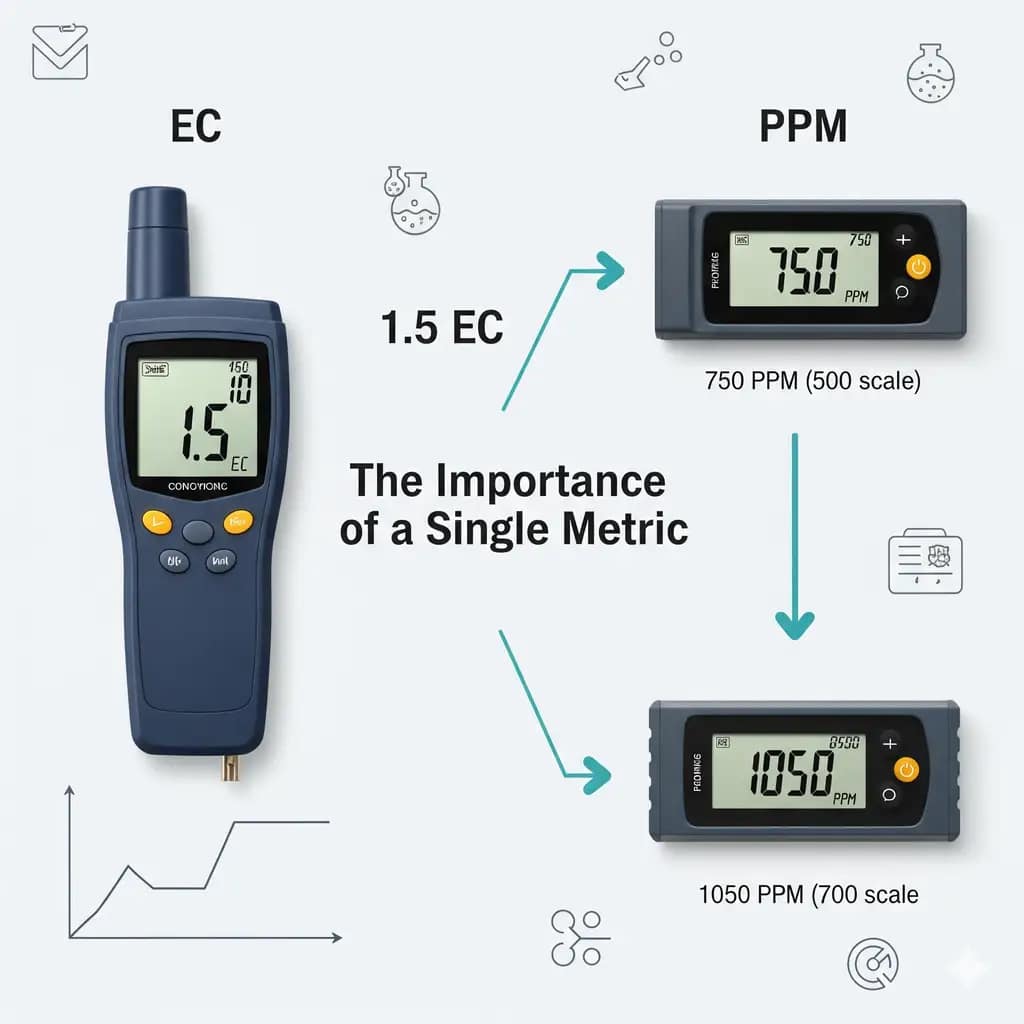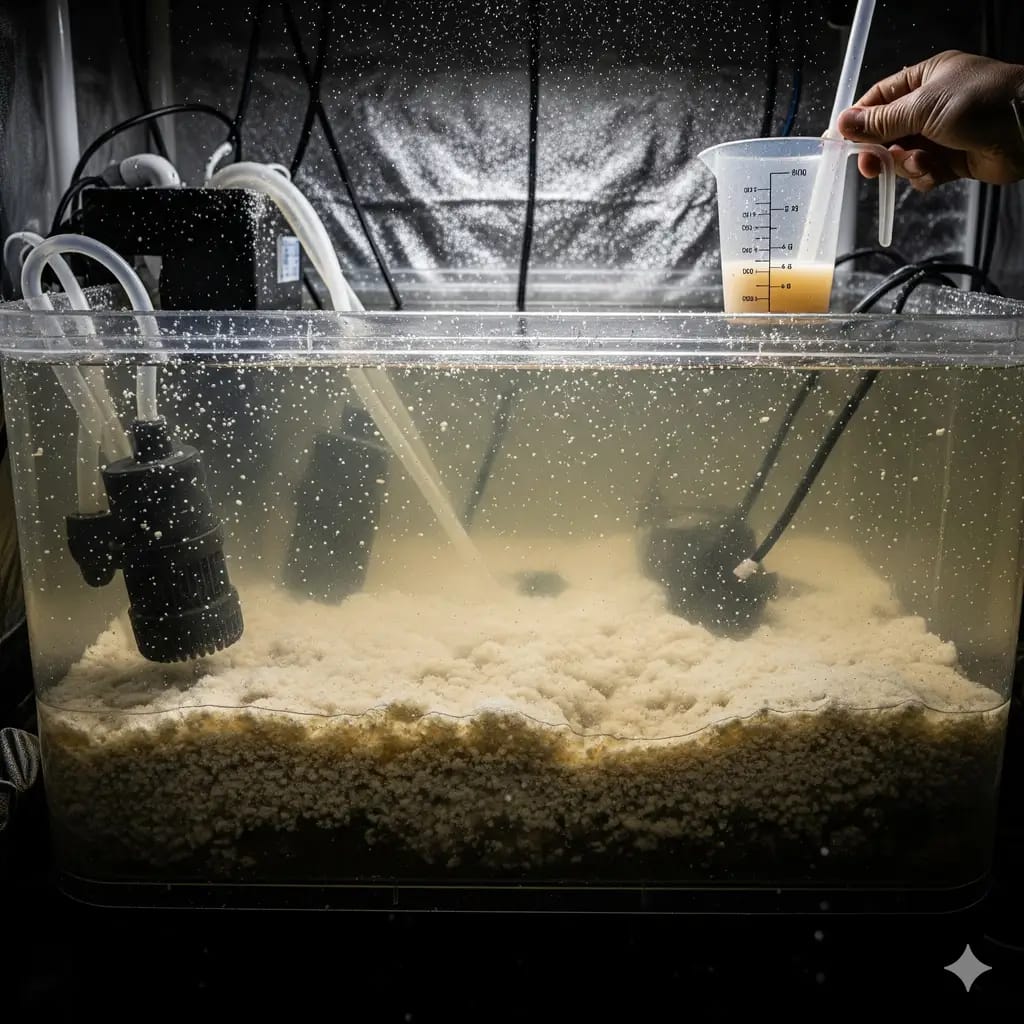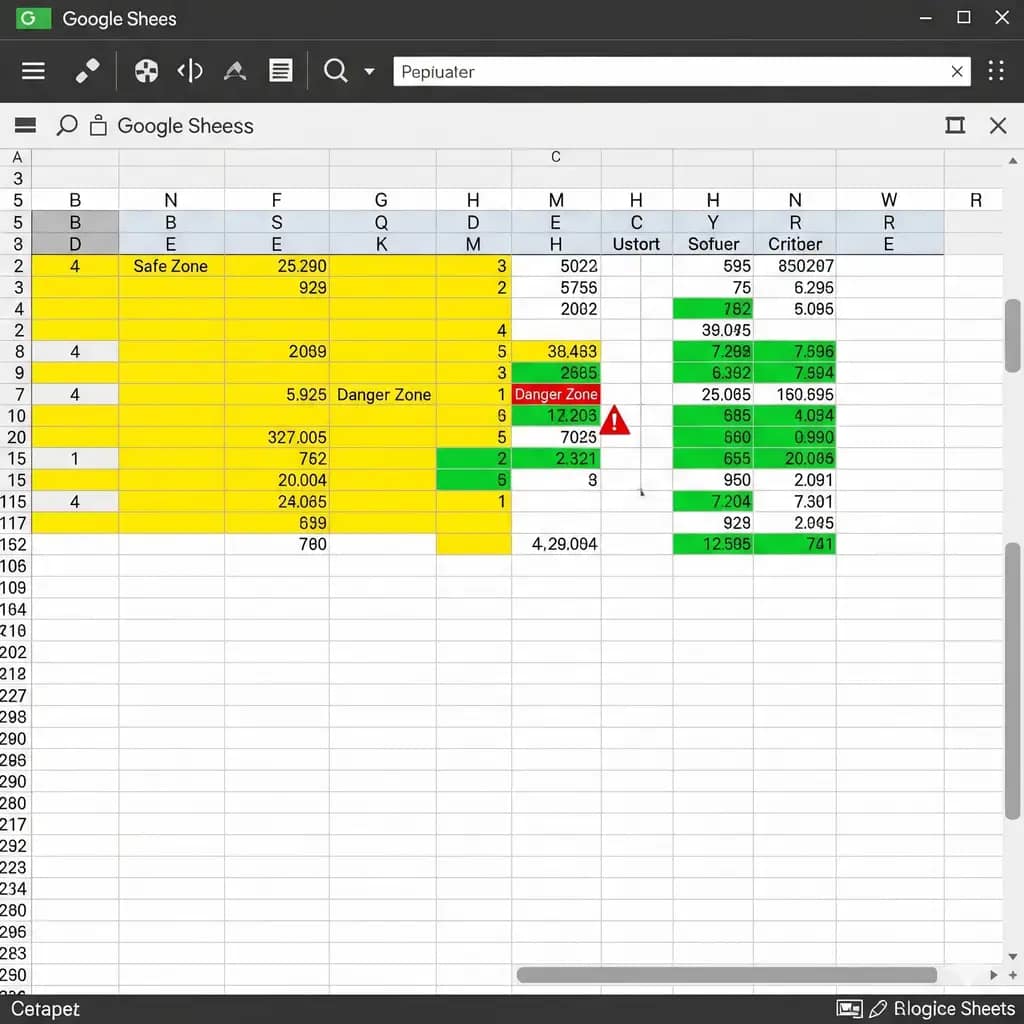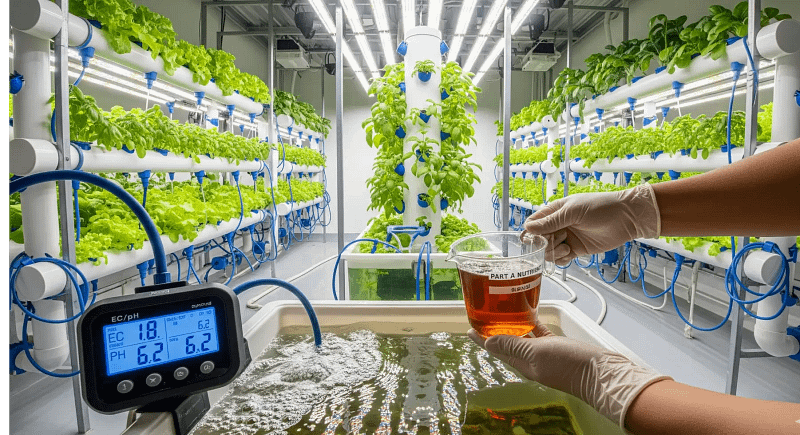In my early days as a hydroponic chemist, I made a grave mistake. I destroyed a crop of 50 basil plants by simply eyeballing my nutrient ratios. The leaves turned yellow, the roots turned brown, and the whole grow smelled like regret. The failure cost me weeks of work and a lot of expensive nutrients. That was my first lesson: bad math kills plants. I once killed a whole crop of seedlings trusting a $5 Amazon EC pen. I learned the hard way that a successful hydroponic garden isn’t a game of chance; it’s a game of chemistry, precision, and math.
This guide is for anyone who’s ever looked at a nutrient bottle and felt a wave of confusion. I’ve transformed my lab-tested mixing protocols into a simple, step-by-step guide and a free downloadable calculator template. My goal is to prevent you from making the same mistakes I did. Stop guessing. Start growing with precision.
DISCLAIMER: Template for educational use. All product links and cultivation advice in this guide are intended for educational and novelty research purposes only. The germination and cultivation of certain plants, especially those that are federally or locally restricted, may violate local laws. You are responsible for consulting with and adhering to all local, state, and federal regulations regarding your cultivation activities. We assume zero liability.
EC vs. PPM – What Actually Matters
Walk into any hydro store and you’ll hear a debate between EC and PPM. What’s the difference, and which one should you use? The answer is simple: they both measure the same thing—the concentration of dissolved nutrient salts in your water.
- EC (Electrical Conductivity): Measures how well your solution conducts electricity. It’s the universal standard in commercial agriculture.
- PPM (Parts Per Million): An approximation of EC. It measures the total amount of dissolved solids in your water. There are two different conversion scales (500 and 700), so if you’re not careful, a “1000 PPM” reading could mean two different things.

Pro Tip: Stick to one scale (500 or 700) to avoid confusion. For simplicity, use EC. It’s the most accurate and universally accepted metric.
EC vs PPM Conversion Table
| EC (mS/cm) | PPM (500 scale) | PPM (700 scale) |
| 0.5 | 250 | 350 |
| 1.0 | 500 | 700 |
| 1.5 | 750 | 1050 |
| 2.0 | 1000 | 1400 |
The 4 Must-Know Calculator Inputs
Before you can mix a single drop of nutrient solution, you need to understand the four key variables that go into a hydroponic nutrient calculator.
Variables Explained
| Variable | Description | Why It Matters |
| Tank Size | The total volume of your reservoir | Determines the total volume of nutrients needed. |
| Current EC | The EC of your tap/RO water | Provides a baseline for your final nutrient concentration. |
| Target EC | The ideal EC for your crop stage | Ensures your plants get a perfect meal every time. |
| Nutrient Brand | The brand you are using (e.g., GH Flora) | Each brand has its own specific mixing ratios. |
Step-by-Step Mixing Order

Mixing nutrients is like baking—the wrong order gives you a flat cake. Reversed order causes nutrient snowstorms. This is a crucial step that can prevent a mixing disaster.
- Water First: Always start with your full volume of water.
- Add pH Adjustments: If you need to adjust your starting water pH, do it now. This is a critical step, as pH affects nutrient absorption later on.
- Add Part A: Add your primary nutrient solution (the N-P-K blend) and mix thoroughly.
- Add Part B: Add your micronutrient solution (cal-mag, iron, etc.) and mix thoroughly.
- Add Boosters: Add any boosters (root stimulants, bloom boosters, etc.) and mix thoroughly.
- Final Check: Use your EC and pH meter to check your final solution. Adjust as needed.
Disaster Alert: Never mix concentrated nutrients directly together. This causes a chemical reaction that creates a precipitate (a “nutrient snowstorm”) that makes your nutrients unusable.
Free Downloadable Template
Tired of doing the math yourself? I’ve built a simple, foolproof Google Sheets calculator that does all the work for you. It auto-adjusts the nutrient volume based on your tank size and plant stage. It also flags dangerous EC levels to prevent nutrient burn.
Instructions:
- Yellow cells are your inputs.
- Green cells are your safe zones.
- Red cells are your danger zones.
- The template also includes a printable cheat sheet for quick reference.

Sanity Checks for Your Readings
EC is like a plant’s blood sugar—too high or too low, and you’re in for a world of pain. A sanity check of your final solution will save you from a nutrient disaster.
- Too Low?
- Seedlings: 0.8-1.0 EC is your happy place6.
- Veg: 1.2-1.8 EC is a great range for fast, leafy growth.
- Flower: 1.8-2.5 EC is a good target for a bountiful harvest.
- Too High?
- The Fix: If your EC is too high, simply add more plain water to dilute the solution7. Then, recheck your pH and EC.
Affiliate Toolkit – Meters That Won’t Lie
A good EC meter is the most important tool you can own. A cheap one will lie to you, and a lie will cost you your entire crop. An $80 meter is a lot cheaper than a $500 crop loss.
UNI-T UT383BT Lux Meter (with Bluetooth App)
A digital light meter that measures lux, which can be accurately converted to PPFD for optimizing light distance and intensity.
- UNI-T professional digital illuminance meter UT383BT. Effectively measures light intensity and display results in units …
- IOS/Android APP & Free download. Breeze through data recording, export, storage and analysis. Measurement data is transf…
- Compact & easy to use. Large 4 digital LCD screen with backlight. 0.5 s sampling time. Overload indication. Max/Min. Dat…
Why Growers Love It:
- Data-Driven Cultivation: Provides quantifiable light data, removing the guesswork from determining if your plants are receiving optimal light levels.
- Bluetooth Connectivity: The accompanying app logs and graphs data over time, allowing for precise tracking and adjustment of light intensity.
- High Accuracy for LED: Delivers reliable lux readings that, when converted using a standard factor, provide a highly accurate estimate of PPFD for full-spectrum white LED lights.
The Trade-Off:
- Conversion Required: It measures lux, not direct PPFD. Users must apply a conversion factor (typically between 0.014 and 0.017 for quantum boards) to estimate PAR values.
Bottom Line for Growers:
If you’re serious about nailing your light distance and intensity, you need data. This meter is the most cost-effective way to stop guessing and start optimizing your PAR levels like a pro. See Latest Discount.
General Hydroponics Flora Series Performance Pack
The industry-standard three-part nutrient system that offers complete control over vegetative and blooming phases.
- The Flora Series is a hydroponic-based nutrient system that helps fulfill your plants’ nutrient needs at every stage of …
- Nutrients included in the Series are FloraMicro, FloraBloom, and FloraGro
- FloraMicro: contains nitrogen and calcium, as well as trace minerals, which are essential for a comprehensive hydroponic…
Top-Shelf Features:
- Unmatched Control: The separate Grow, Micro, and Bloom bottles allow you to tailor the NPK ratio precisely for each stage of growth, as detailed in nutrient calculators.
- pH Stability: The formula is buffered to help maintain a stable pH in the reservoir, reducing the frequency of adjustments.
- Proven Reliability: Used by hobbyists and commercial growers worldwide for decades; it’s a trusted formula that delivers consistent results.
Room for Improvement:
- Learning Curve: Requires more understanding and attention than a simple one-part nutrient, as you must mix multiple components in the correct order.
- Ongoing Cost: While the initial pack is a great value, you will need to restock the individual bottles you use most frequently.
Is It Right For Your Garden?
If you are ready to move beyond all-in-one nutrients and want the precision to truly “mix like a pro,” this is the definitive system to learn on. It is the practical application of everything the nutrient calculator article teaches. See Latest Discount.
VIVOSUN Digital pH and TDS Meter Combo Kit
A must-have duo for accurately monitoring the pH and strength (PPM/EC) of your nutrient solution.
- Application: Great for all home and laboratory TDS & pH testing applications including aquariums, swimming pools
- PH Meter: Full measurement range of pH 0 – 14, reliable and quick readings
- 3-in-1 TDS Meter: Measurement Range 0-9990ppm, 0-9990µs/cm; Accuracy ± 2%, 0.1- 80.0°C, 32.0-176.0°F; Note: This meter c…
Root-Level Benefits:
- Dual-Parameter Monitoring: The pH meter prevents nutrient lockout, while the TDS (PPM) meter ensures your solution strength is perfectly aligned with your calculations and plant stage.
- Auto-Calibration & Temp Compensation: The pH meter features automatic calibration (with solution) for hassle-free accuracy and reliable readings.
- Complete Kit: Comes with storage solutions, calibration powder, and protective caps, which are essential for maintaining the longevity and accuracy of the meters.
A Word of Caution:
- Requires Proper Maintenance: The probes must be kept clean and stored with the protective caps filled with storage solution to prevent them from drying out and becoming inaccurate.
The Final Verdict:
You cannot effectively use a nutrient calculator without these tools. They are the eyes into your reservoir, providing the critical data needed to mix accurately and avoid costly mistakes. This combo kit is an affordable and reliable entry point. Check Price on Amazon.
VIVOSUN Digital pH and TDS Meter Combo Kit
A premium fulvic acid supplement that enhances nutrient uptake and improves plant resilience.
- General Hydroponics Diamond Nectar 0-1-1 is a high-quality nutrient additive
- Apply to all crops, including vegetable crops, row crops, field crops, trees, vines, ornamentals, gardens, and landscapi…
- Add to fertilizer mix for plants growing in soil, potting mixes, soilless rooting media, and hydroponics
Bloom & Boost:
- Supercharges Nutrient Uptake: Fulvic acid chelates nutrients, making them more readily available for absorption by the plant’s roots, ensuring your precise calculations are fully utilized.
- Improves Plant Health: Enhances cell wall permeability and stimulates beneficial microbial activity in the root zone, leading to stronger, more vigorous plants.
- Works with Any Line: This is an additive that can be used with any nutrient system to increase its efficiency and effectiveness.
Not a Perfect Fit For:
- Absolute Beginners: This is an advanced additive for growers who have already mastered the basics of EC and pH management and are looking to optimize further.
Who This Is For:
The grower who has already dialed in their base nutrients and is looking for that extra edge. It ensures the carefully calculated recipe you mix is absorbed as efficiently as possible. See Latest Discount.
FAQ – Nutrient Mixing Mysteries Solved
What is the difference between EC and PPM, and which one should I use?
EC (Electrical Conductivity) and PPM (Parts Per Million) both measure the concentration of dissolved nutrient salts in your water. EC is the universal standard in commercial agriculture, while PPM is a less precise approximation that uses different conversion scales. For accuracy and consistency, you should always use EC.
Why is the order in which I mix my hydroponic nutrients so important?
Mixing nutrients in the wrong order can cause a “nutrient snowstorm,” which is a chemical reaction that creates unusable precipitates. The correct order is to always start with your water, add pH adjustments, then add your primary nutrients, followed by any boosters, and finally, do a final check of your EC and pH.
What is the biggest mixing mistake beginners make?
The biggest mistake beginners make is not checking their pH. If your pH is out of the ideal range of 5.5 to 6.5, your plants can’t absorb the nutrients, even if your EC is perfect. This can lead to what’s known as nutrient lockout, and your plants will show signs of deficiency.
How do I know if my final nutrient solution is too strong?
If your nutrient solution is too strong, your plants will show signs of nutrient burn, which can manifest as crispy, yellow, or brown leaf tips. The best way to check is to use a calibrated EC meter. If your EC is too high for your crop stage, you should dilute it with plain, pH-adjusted water.
How can I determine the right EC for my plants?
The ideal EC for your plants depends on their growth stage. Seedlings and clones need a low EC (0.8-1.0), the vegetative stage requires a moderate EC (1.2-1.8), and the flowering or fruiting stage requires a higher EC (1.8-2.5) to support a bountiful harvest.
WARNING: Overfeeding kills plants. Cannabis laws vary. Template for legal crops only.





